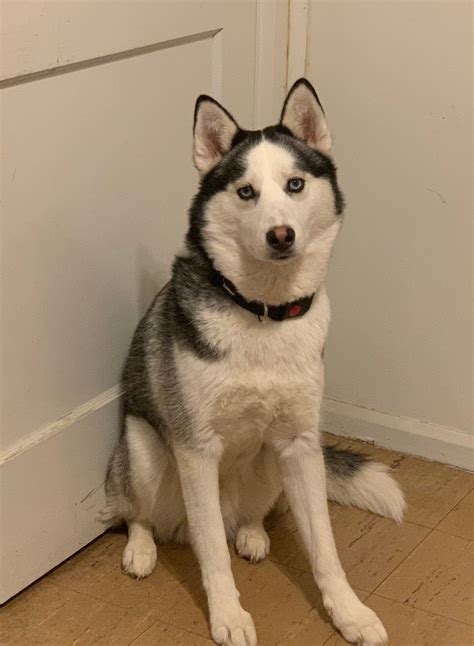
A 10-month-old baby’s introduction to the family’s Siberian Husky has ignited a frenzy of excitement, captured in a viral video showcasing the dog’s enthusiastic reaction to its new “baby sister.”
The internet is abuzz with a heartwarming video depicting the unbridled joy of a Siberian Husky meeting his 10-month-old human sibling for the very first time. The viral sensation, originally posted on TikTok by user @Kirstendi, shows the canine companion’s overwhelming excitement as he finally gets to interact with the newest member of the family, after what the family describes as a long wait. The video has garnered millions of views and countless comments, highlighting the special bond between children and their pets and demonstrating the captivating reactions of animals.
The video opens with the husky, named Atlas, positioned just outside a baby gate, his eyes fixed intently on the baby sitting on the floor inside the enclosure. The family can be heard encouraging Atlas to approach gently, but his pent-up anticipation is palpable. As the gate opens, Atlas erupts in a flurry of happy vocalizations, playful leaps, and tail wags, circling the baby with unrestrained enthusiasm. The baby, seemingly unfazed by the canine commotion, responds with giggles and reaches out to touch Atlas.
Kirsten, the baby’s mother and the video’s creator, explained that Atlas had been patiently waiting to meet the baby since she was born. Due to concerns about safety and allowing the baby to develop some strength and coordination, the family had waited until they felt the time was right to introduce them properly. “He has been so patient waiting for her,” Kirsten wrote in the video’s caption. “Now they’re besties.”
The video has resonated with pet lovers and parents alike, drawing attention to the unique and often heartwarming relationship between children and their animal companions. Many commenters shared their own stories of similar introductions, highlighting the protective instincts and unconditional love that pets often display towards young children. Some comments noted the initial concerns about introducing such a large and energetic breed like a husky to a small baby, but the video clearly demonstrates Atlas’s gentle nature and genuine affection for his new “sister.”
The video’s popularity also underscores the growing trend of pet owners treating their animals as integral members of the family. Pets are increasingly seen as companions, confidants, and sources of emotional support, playing significant roles in the lives of their human owners. This bond is often amplified when children are involved, as pets can provide companionship, teach responsibility, and foster empathy.
Veterinarians and animal behaviorists often recommend careful and supervised introductions between pets and babies to ensure a safe and positive experience for everyone involved. Gradual exposure, positive reinforcement, and clear boundaries are key to establishing a harmonious relationship between the child and the animal.
The success of this particular introduction, as captured in the viral video, serves as a reminder of the potential for deep and meaningful connections between children and their pets, provided that the introduction is handled responsibly and with careful consideration for the well-being of both the child and the animal. The video is a testament to the enduring appeal of interspecies friendship and the joy that animals can bring to our lives.
In-Depth Analysis and Background Information:
The viral video of Atlas meeting his baby sister taps into a deep-seated human fascination with the bond between children and animals. This connection is not just anecdotal; it’s supported by scientific research that highlights the numerous benefits of pet ownership for children’s development.
Benefits of Pets for Children:
- Emotional Development: Pets can provide unconditional love and companionship, helping children develop a sense of security and self-esteem. They can also teach children about empathy and compassion, as they learn to care for another living being.
- Social Skills: Interacting with pets can improve children’s social skills, as they learn to communicate and cooperate with animals. Pets can also serve as social catalysts, helping children make friends and connect with others who share their love of animals.
- Physical Health: Studies have shown that children who grow up with pets have a lower risk of allergies and asthma. Pets also encourage physical activity, as children play with and care for their animals.
- Cognitive Development: Pets can stimulate children’s cognitive development by encouraging them to learn about animal behavior, biology, and responsibility. They can also improve children’s reading skills, as they practice reading aloud to their pets.
- Responsibility and Routine: Caring for a pet teaches children responsibility. They learn the importance of feeding, grooming, and exercising their animal, which instills a sense of routine and discipline.
Siberian Huskies: Breed Characteristics and Considerations:
Siberian Huskies are known for their friendly and outgoing personalities, making them popular family pets. However, they are also a high-energy breed that requires a significant amount of exercise and mental stimulation. Understanding the breed’s characteristics is crucial before bringing a husky into a home with young children.
- Energy Levels: Huskies were originally bred to pull sleds over long distances, so they have a seemingly endless supply of energy. They need daily exercise, such as running, hiking, or playing fetch, to stay happy and healthy.
- Prey Drive: Huskies have a strong prey drive, which means they may be tempted to chase small animals, such as squirrels or cats. It’s important to train huskies to be around other animals from a young age to minimize the risk of chasing.
- Socialization: Huskies are social animals that thrive on human interaction. They need to be properly socialized from a young age to prevent them from becoming shy or aggressive.
- Training: Huskies are intelligent but independent dogs, which can make them challenging to train. They respond best to positive reinforcement methods, such as treats and praise.
- Grooming: Huskies have a thick double coat that sheds heavily, especially during the spring and fall. They need to be brushed regularly to prevent matting and tangles.
In the context of the viral video, it’s evident that the family took the necessary precautions to ensure a safe and positive introduction between Atlas and the baby. They waited until the baby was old enough to interact with the dog, and they supervised the introduction closely. It’s also clear that Atlas has been well-socialized and trained, as he displays gentle and affectionate behavior towards the baby.
Ethical Considerations of Viral Pet Videos:
While heartwarming videos like the one featuring Atlas can bring joy to viewers, it’s important to consider the ethical implications of sharing such content online.
- Privacy: Sharing videos of children online raises privacy concerns, as it exposes them to a wide audience without their consent. Parents should carefully consider the potential risks before posting videos of their children online.
- Exploitation: Some viral pet videos may be staged or manipulated for entertainment purposes, potentially exploiting the animals involved. It’s important to be critical of the content you consume and to support creators who prioritize the well-being of their animals.
- Misrepresentation: Viral videos can sometimes create unrealistic expectations about pet ownership. It’s important to remember that every animal is different, and not all pets will react the same way to new situations.
- Cyberbullying and Harassment: Online platforms can be breeding grounds for cyberbullying and harassment. Pet owners who share videos of their animals may be targeted by online trolls who criticize their parenting or animal care practices.
Expert Opinions on Pet and Baby Introductions:
Veterinarians and animal behaviorists offer valuable advice on how to safely and successfully introduce pets to babies.
Dr. Sarah Wooten, DVM, CVJ, a veterinarian and veterinary journalist, emphasizes the importance of gradual introductions. “Start by allowing the pet to sniff the baby’s scent on a blanket or article of clothing,” she advises. “Then, gradually increase the pet’s exposure to the baby, always under supervision.”
Dr. Emily Levine, DVM, DACVB, a veterinary behaviorist, recommends using positive reinforcement to create positive associations between the pet and the baby. “Reward the pet for calm and gentle behavior around the baby,” she says. “Avoid punishing the pet for showing signs of jealousy or anxiety.”
Both experts agree that it’s crucial to create a safe space for the pet where it can retreat from the baby if it feels overwhelmed. This could be a crate, a bed, or a separate room. It’s also important to teach children how to interact with pets respectfully, avoiding behaviors that could frighten or annoy them.
The viral video of Atlas meeting his baby sister provides a heartwarming example of a successful pet and baby introduction. However, it’s important to remember that every situation is different, and careful planning and supervision are essential for ensuring a safe and positive experience for everyone involved. The video highlights the joy and companionship that pets can bring to our lives, but it also underscores the importance of responsible pet ownership and ethical considerations when sharing content online.
The family’s decision to wait until the baby was ten months old before formally introducing her to the husky reflects a responsible approach to pet ownership and child safety. This waiting period allowed the baby to develop some motor skills and a degree of awareness, reducing the risk of accidental injury during interactions. Similarly, it provided the family with ample time to prepare Atlas for the arrival of the baby and to manage his expectations.
The viral nature of the video also speaks to a broader cultural trend: the increasing anthropomorphization of pets. Many pet owners view their animals as full-fledged members of the family, attributing human-like emotions and motivations to them. While this can lead to stronger bonds between humans and animals, it’s important to remember that pets have their own unique needs and perspectives, which may not always align with human expectations.
Furthermore, the comments section of the video reveals a wide range of opinions and experiences related to pet and baby introductions. Some commenters shared their own success stories, while others expressed concerns about potential risks. This diversity of perspectives highlights the complexity of the issue and the importance of considering individual circumstances when making decisions about pet and baby interactions.
The video’s impact extends beyond mere entertainment. It serves as a reminder of the potential for positive relationships between children and animals, and it encourages responsible pet ownership practices. By showcasing the joy and companionship that pets can bring to our lives, the video inspires others to consider the benefits of adding a furry friend to their family. However, it also underscores the importance of careful planning, supervision, and ethical considerations when introducing pets to babies and sharing content online.
Frequently Asked Questions (FAQ):
-
How old was the baby when she was introduced to the Husky?
The baby was 10 months old when she was formally introduced to the Husky, named Atlas.
-
What breed of dog is Atlas?
Atlas is a Siberian Husky.
-
Why did the family wait so long to introduce the baby and the dog?
The family waited to ensure the baby had developed some strength and coordination and to allow them to properly prepare Atlas for the introduction, prioritizing safety for both.
-
What was the Husky’s reaction when he finally met the baby?
Atlas displayed overwhelming excitement, including happy vocalizations, playful leaps, tail wags, and gentle circling around the baby.
-
Where was the video of the introduction originally posted?
The video was originally posted on TikTok by user @Kirstendi.
-
What did Kirsten say about the relationship between Atlas and the baby now?
Kirsten said “Now they’re besties.” indicating a positive and close bond between the baby and the husky.
-
What are some of the benefits of children growing up with pets, according to experts?
Pets can provide emotional support, teach responsibility, improve social skills, promote physical activity, and lower the risk of allergies.
-
What precautions should families take when introducing a dog to a baby?
Gradual introductions, supervised interactions, positive reinforcement, and creating safe spaces for the dog are crucial.
-
What are some things to consider before getting a husky as a family pet?
Huskies are high-energy dogs requiring significant exercise, training, and socialization. Their thick coat also requires regular grooming. Families should consider if they can meet these needs.
-
Are there any ethical considerations when posting videos of children and pets online?
Yes, privacy concerns, potential exploitation, misrepresentation of pet ownership, and the risk of cyberbullying should be considered.
Expanded Context:
The story of Atlas and his baby sister is not just a heartwarming anecdote; it’s a microcosm of the complex and evolving relationship between humans and animals in modern society. As pets become increasingly integrated into our families, the ways in which we interact with them, care for them, and even perceive them are undergoing significant changes.
One of the most notable trends is the aforementioned anthropomorphization of pets. This involves attributing human-like qualities, emotions, and motivations to animals. While this tendency can strengthen the emotional bond between humans and pets, it can also lead to unrealistic expectations and potentially harmful practices.
For example, pet owners who anthropomorphize their animals may be more likely to overfeed them, dress them in clothing, or subject them to unnecessary medical procedures. They may also misinterpret their pets’ behavior, leading to misunderstandings and communication breakdowns.
Another important aspect of the human-animal relationship is the growing recognition of the mental and emotional needs of pets. Veterinarians, animal behaviorists, and other experts are increasingly emphasizing the importance of providing pets with enriching environments, stimulating activities, and opportunities for social interaction.
This shift in perspective reflects a growing understanding of animal cognition and sentience. Scientists have made significant strides in recent years in uncovering the complex cognitive abilities of animals, demonstrating that many species are capable of problem-solving, learning, and experiencing a wide range of emotions.
As our understanding of animal cognition grows, so too does our ethical responsibility to treat animals with respect and compassion. This includes providing them with adequate food, shelter, and medical care, as well as protecting them from cruelty and exploitation.
In the context of pet ownership, this means making informed decisions about the type of animal to acquire, the resources required to care for it properly, and the potential impact on the animal’s well-being. It also means being mindful of the ethical implications of breeding, selling, and trading animals.
The viral video of Atlas and his baby sister highlights the potential for positive and fulfilling relationships between humans and animals. However, it also underscores the importance of responsible pet ownership, ethical considerations, and a deeper understanding of the complexities of the human-animal bond.
The story also touches upon the anxieties many new parents face when introducing a pet to a newborn or young child. Concerns about safety, potential jealousy on the part of the pet, and the added responsibility of caring for both a child and an animal are common. Families often seek advice from veterinarians, trainers, and experienced pet owners to navigate this transition successfully.
Strategies often recommended include:
- Scent Introduction: Before the baby comes home, introduce the pet to the baby’s scent by bringing home a blanket or item of clothing that the baby has used.
- Controlled Greetings: When the baby first arrives, allow the pet to greet the baby from a safe distance, such as on a leash or behind a baby gate.
- Supervised Interactions: Always supervise interactions between the pet and the baby, especially in the early stages. Never leave them alone together.
- Positive Reinforcement: Reward the pet for calm and gentle behavior around the baby.
- Designated Safe Spaces: Provide the pet with a safe space where it can retreat from the baby if it feels overwhelmed.
- Training and Socialization: Ensure that the pet is properly trained and socialized to help it adapt to the presence of a baby.
- Consistency: Maintain a consistent routine for the pet to help it feel secure and avoid jealousy.
In addition to these practical strategies, it’s important to be patient and understanding. It may take time for the pet to adjust to the presence of a baby, and there may be setbacks along the way. However, with careful planning, consistent effort, and a positive attitude, most families can successfully integrate a pet into their lives with a new baby.
The viral success of the Atlas video also reveals the power of social media to shape perceptions and attitudes towards animals. Positive stories like this can help to promote responsible pet ownership and highlight the benefits of the human-animal bond. However, it’s also important to be aware of the potential for social media to spread misinformation and promote unrealistic expectations.
Pet owners should be critical of the content they consume online and seek out reliable sources of information from veterinarians, trainers, and other experts. They should also be mindful of the privacy and well-being of their pets when sharing content online.
Ultimately, the story of Atlas and his baby sister is a reminder of the joy, companionship, and unconditional love that animals can bring to our lives. By embracing responsible pet ownership practices, fostering a deeper understanding of animal cognition, and being mindful of the ethical considerations involved, we can ensure that the human-animal bond continues to thrive for generations to come.









